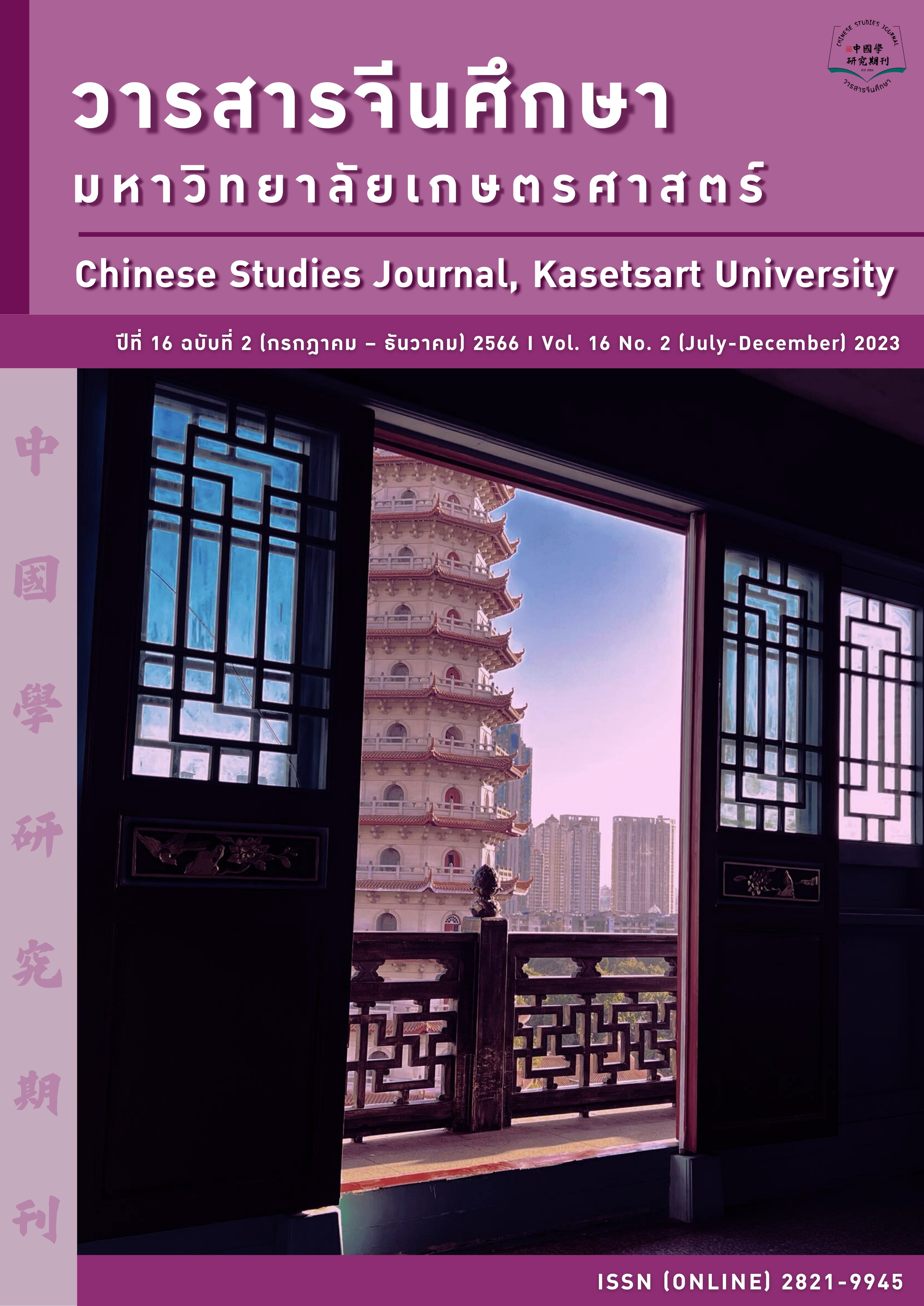‘A-Zhong’ Nationalist Discourse in Comments on Weibo วาทกรรมชาตินิยม ‘อาจง’ (阿中) ในคอมเมนต์บนแพลตฟอร์มเวยป๋อ
Main Article Content
Abstract
This study examines the 'A-Zhong' nationalist discourse present in Weibo comments, focusing on the linguistic strategies and techniques shaping this discourse. The research involved gathering data from comments and sub-comments with over 100 likes on Weibo posts containing the term ‘A-Zhong' from ten news agencies. The data, gathered between August and December 2019, was analyzed to understand the concepts of nationalism and the linguistic strategies in nationalist discourse. The findings reveal that the 'A-Zhong' nationalist discourse aims to achieve three objectives: 1) Celebrating the state, 2) Depicting state adversaries, and 3) Encouraging unity and solidarity. The linguistic strategies employed are categorized into four groups: 1) Usage of positively connoted words and phrases, 2) Utilization of negatively connoted words and phrases, 3) Assertion of claims, and 4) Employment of metaphors. These strategies collectively strengthen a sense of national identity and pride among Chinese citizens, reinforce their commitment to defend the nation and promote a spirit of unity.
Article Details

This work is licensed under a Creative Commons Attribution-NonCommercial-NoDerivatives 4.0 International License.
ผลงานทางวิชาการที่ลงตีพิมพ์ในวารสารจีนศึกษา มหาวิทยาลัยเกษตรศาสตร์ เป็นลิขสิทธิ์ของผู้เขียนหรือผู้แปลผลงานนั้น หากนำลงในวารสารจีนศึกษาเป็นครั้งแรก เจ้าของผลงานสามารถนำไปตีพิมพ์ซ้ำในวารสารหรือหนังสืออื่นได้โดยมิต้องแจ้งให้ทราบล่วงหน้า แต่หากผลงานที่ได้รับพิจารณานำลงในวารสารจีนศึกษา เป็นผลงานที่เคยตีพิมพ์ที่อื่นมาก่อนเจ้าของผลงานต้องจัดการเรื่องปัญหาลิขสิทธิ์กับแหล่งพิมพ์แรกเอง หากเกิดปัญหาทางกฎหมาย ถือว่าไม่อยู่ในความรับผิดชอบของวารสารจีนศึกษา มหาวิทยาลัยเกษตรศาสตร์ ทั้งนี้ ความคิดเห็นต่างๆ ในบทความเป็นความคิดเห็นส่วนตัวของผู้เขียน ไม่เกี่ยวกับกองบรรณาธิการวารสารจีนศึกษา มหาวิทยาลัยเกษตรศาสตร์
References
จันทิมา อังคพณิชยกิจ. (2557). การวิเคราะห์ข้อความ. มหาวิทยาลัยธรรมศาสตร์.
ชัชวดี ศรลัมพ์. (2548). อุปลักษณ์ตามแนวคิดของทฤษฎีภาษาศาสตร์ปริชาน. วารสารศิลปศาสตร์มหาวิทยาลัยธรรมศาสตร์,
(1), 3.
นัยนา วงศ์สาคำ. (2559). ภาษากับอุดมการณ์การศึกษาในรายการโทรทัศน์ “เดินหน้าประเทศไทย”. วารสารศิลปศาสตร์
มหาอุบลราชธานี. 12(2), 55-81.
เปรมโรจน์ บางอ้อ. (2556). แนวคิด “ชาตินิยม” ในแบบเรียนประวัติศาสตร์ ระดับชั้นประถมศึกษา ในหลักสูตรแกนกลาง
การศึกษาขั้นพื้นฐาน พุทธศักราช 2551. [วิทยานิพนธ์ปริญญามหาบัณฑิต, มหาวิทยาลัยศรีนครินทรวิโรฒ].
วณิชชา โนภาศ. (2563). วาทกรรมกับการสร้างอุดมการณ์ทางการเมืองในรายการคืนวันศุกร์ให้ประชาชน การศึกษาตาม
แนววาทกรรมวิเคราะห์เชิงวิพากษ์. [วิทยานิพนธ์ปริญญามหาบัณฑิต, มหาวิทยาลัยอุบลราชธานี].
วิสันต์ สุขวิสิทธิ์. (2554). ความสัมพันธ์ระหว่างภาษากับอุดมการณ์ในหนังสือเรียนรายวิชาภาษาไทยตามหลักสูตรประถมศึกษา
พ.ศ. 2503-2544: กรณีศึกษาตามแนววาทกรรมวิเคราะห์เชิงวิพากษ์. [วิทยานิพนธ์ปริญญาอักษรศาสตรดุษฎีบัณฑิต,
จุฬาลงกรณ์มหาวิทยาลัย].
สิทธิชัย สุขคะตะ และ ณัฐวีณ์ บุนนาค. (2558). การวิเคราะห์วาทกรรมชาตินิยมไทยในแบบเรียนสังคมศึกษาและประวัติศาสตร์.
วารสารสหวิทยาการวิจัย: ฉบับบัณฑิตศึกษา, 4 (1), 126-137.
Anderson, B. (2016). Imagined Communities. Verso Books.
China Digital Times. (2022). 阿中哥哥. https://chinadigitaltimes.net/space/%E9%98%BF%E4%B8%AD%
E5%93%A5%E5%93%A5
Fairclough, N. (1995). Media Discourse. Edward Arnold.
Fairclough, N. (2003). Analysis Discourse: Textual Analysis for Social Research. Routledge.
Foucault, M. (1981). The Order of Discourse, in Young, R. (Ed.), Untying the Text: A Post-Structuralist Reader.
(pp. 51-78). Routledge.
HenryPrince刘宪华王子乐器铺. (2018, June 22). 饭圈科普之控评. Weibo. https://www.weibo.com/
ttarticle/p/show?id=2309404253503974432260
Lakoff, G & Johnson, M. (1998). Metaphor We Live by. The University of Chicago Press.
陈苓钰.(2021).正名与共赢:饭圈亚文化与主流文化互动的新模式——基于饭圈女孩“守护阿中哥哥”
行动的分析.泉州师范学院学报,39(03),85-89.
胡泳、刘纯懿.(2021).现实之镜:饭圈文化背后的社会症候.新闻大学,(08),65-79.
刘一洁.(2022).劳动的漩涡:粉丝控评的行为机制研究——以传播政治经济学为研究视角.科技传播, (12): 67-70.
乔木.(2021). 警惕网络“控评”.法人,(03),94-95.
秦琴.(2021).“饭圈文化”的语言与圈层属性.今古文创,(42),118-119.
沈基松、姜露露.(2020).阿中哥:当代中国形象的拟人化称谓.汉字文化,(01),85-87.


